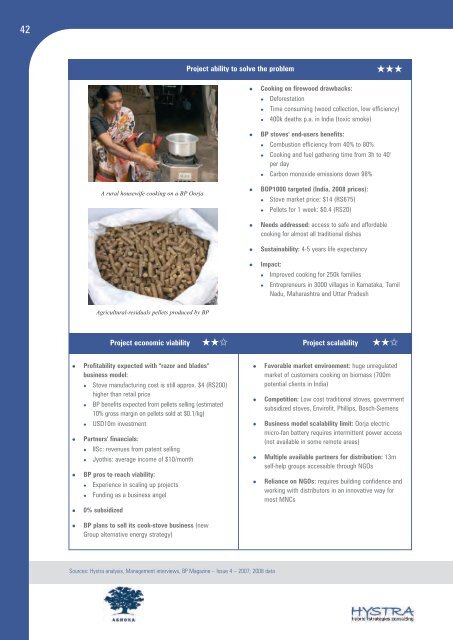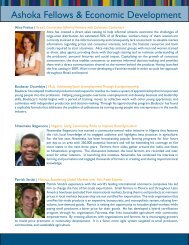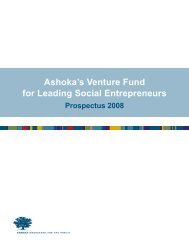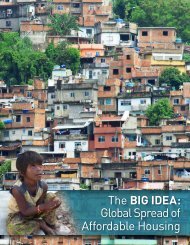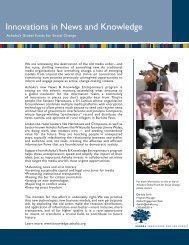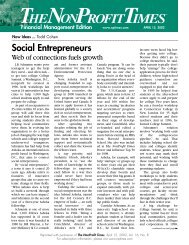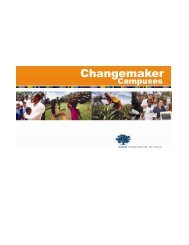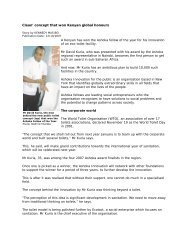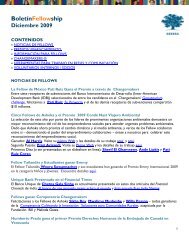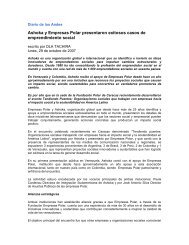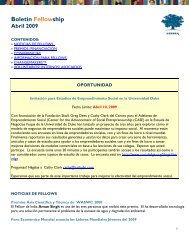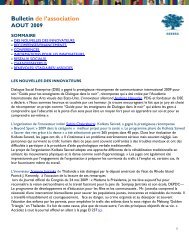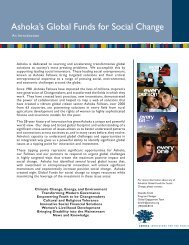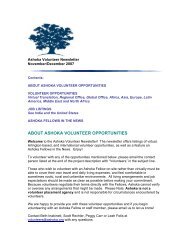Access to Energy for the Base of the - Ashoka
Access to Energy for the Base of the - Ashoka
Access to Energy for the Base of the - Ashoka
Create successful ePaper yourself
Turn your PDF publications into a flip-book with our unique Google optimized e-Paper software.
42<br />
� Cooking on firewood drawbacks:<br />
� De<strong>for</strong>estation<br />
� Time consuming (wood collection, low efficiency)<br />
� 400k deaths p.a. in India (<strong>to</strong>xic smoke)<br />
� BP s<strong>to</strong>ves' end-users benefits:<br />
� Combustion efficiency from 40% <strong>to</strong> 80%<br />
� Cooking and fuel ga<strong>the</strong>ring time from 3h <strong>to</strong> 40'<br />
per day<br />
� Carbon monoxide emissions down 98%<br />
� BOP1000 targeted (India, 2008 prices):<br />
� S<strong>to</strong>ve market price: $14 (RS675)<br />
� Pellets <strong>for</strong> 1 week: $0.4 (RS20)<br />
� Needs addressed: access <strong>to</strong> safe and af<strong>for</strong>dable<br />
cooking <strong>for</strong> almost all traditional dishes<br />
� Sustainability: 4-5 years life expectancy<br />
� Impact:<br />
� Improved cooking <strong>for</strong> 250k families<br />
� Entrepreneurs in 3000 villages in Karnataka, Tamil<br />
Nadu, Maharashtra and Uttar Pradesh<br />
Project economic viability Project scalability<br />
� Pr<strong>of</strong>itability expected with "razor and blades"<br />
business model:<br />
� S<strong>to</strong>ve manufacturing cost is still approx. $4 (RS200)<br />
higher than retail price<br />
� BP benefits expected from pellets selling (estimated<br />
10% gross margin on pellets sold at $0.1/kg)<br />
� USD10m investment<br />
� Partners' financials:<br />
� IISc: revenues from patent selling<br />
� Jyothis: average income <strong>of</strong> $10/month<br />
� BP pros <strong>to</strong> reach viability:<br />
� Experience in scaling up projects<br />
� Funding as a business angel<br />
� 0% subsidized<br />
A rural housewife cooking on a BP Oorja<br />
Agricultural-residuals pellets produced by BP<br />
� BP plans <strong>to</strong> sell its cook-s<strong>to</strong>ve business (new<br />
Group alternative energy strategy)<br />
Project ability <strong>to</strong> solve <strong>the</strong> problem<br />
Sources: Hystra analysis, Management interviews, BP Magazine – Issue 4 – 2007; 2008 data<br />
★★★<br />
★★✩ ★★✩<br />
� Favorable market environment: huge unregulated<br />
market <strong>of</strong> cus<strong>to</strong>mers cooking on biomass (700m<br />
potential clients in India)<br />
� Competition: Low cost traditional s<strong>to</strong>ves, government<br />
subsidized s<strong>to</strong>ves, Envir<strong>of</strong>it, Phillips, Bosch-Siemens<br />
� Business model scalability limit: Oorja electric<br />
micro-fan battery requires intermittent power access<br />
(not available in some remote areas)<br />
� Multiple available partners <strong>for</strong> distribution: 13m<br />
self-help groups accessible through NGOs<br />
� Reliance on NGOs: requires building confidence and<br />
working with distribu<strong>to</strong>rs in an innovative way <strong>for</strong><br />
most MNCs


